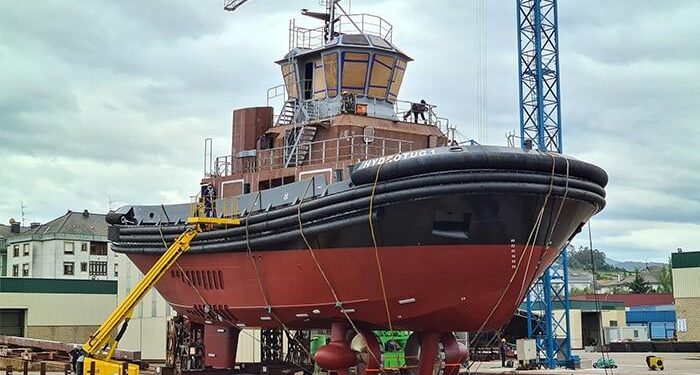China’s First Hydrogen-Electric Tugboat Debuts in Qingdao, Pioneering Sustainable Maritime Operations
In a landmark achievement for the maritime sector, China has introduced its inaugural hydrogen-electric tugboat at the Port of Qingdao. This vessel embodies a transformative approach to eco-conscious shipping by significantly curbing carbon emissions and reducing dependence on fossil fuels. The unveiling event attracted government officials and industry leaders eager to witness this stride toward greener port logistics. This initiative aligns seamlessly with China’s ambitious environmental targets and highlights its role as a frontrunner in adopting clean energy technologies within global maritime operations.
Revolutionizing Port Efficiency with Hydrogen-Powered Tugboats
The newly launched tugboat harnesses hydrogen fuel cell technology, offering an innovative alternative to conventional diesel-powered vessels. By integrating electric propulsion systems with advanced hull designs optimized for hydrodynamics, this tug delivers superior maneuverability while maintaining environmental responsibility.
- Emission-Free Operation: Powered entirely by hydrogen fuel cells, it produces zero greenhouse gases during operation.
- Operational Excellence: Enhanced propulsion efficiency reduces energy consumption and improves responsiveness in tight port environments.
- Noise Reduction: Quiet engine performance minimizes acoustic disturbances, fostering a more peaceful harbor atmosphere.
- Sustainable Cost Savings: Lower fuel expenses over time due to decreased reliance on petroleum-based fuels contribute to economic viability.
This breakthrough not only underscores China’s dedication to green innovation but also sets an example for future naval engineering projects worldwide. Experts anticipate that such vessels will be integral components of increasingly automated and environmentally friendly port ecosystems moving forward.
The Role of Green Technology in Shaping Eco-Friendly Maritime Practices
The deployment of this hydrogen-electric tugboat signals a paradigm shift towards sustainable marine transportation solutions amid growing global concerns about climate change. Unlike traditional tugs that emit significant levels of nitrogen oxides (NOx) and particulate matter harmful to both human health and marine life, hydrogen-powered alternatives offer clean propulsion without compromising performance or reliability.
- No Harmful Emissions: Completely eliminates exhaust pollutants associated with diesel engines.
- Lowers Ambient Noise Levels: Supports quieter operations essential for urban ports surrounded by residential areas.
- Energizes Operational Efficiency: Optimized energy use translates into reduced maintenance needs and longer service intervals.
This advancement arrives at a critical juncture as international maritime regulations tighten emissions standards under frameworks like IMO’s MARPOL Annex VI amendments. The success of such green vessels could accelerate adoption rates across other major ports globally seeking compliance alongside sustainability goals.
The Broader Impact: How Hydrogen Propulsion Could Reshape Global Shipping Hubs
The introduction of hydrogen-fueled tugs is more than just an isolated technological feat; it represents the potential catalyst for widespread transformation within port infrastructures worldwide. As governments enforce stricter environmental policies—such as the European Union’s Fit for 55 package aiming at cutting transport emissions by over 50% by 2030—the demand for zero-emission solutions grows exponentially.[1]
- Sustainability Enhancement: Transitioning fleets reduce air pollution levels dramatically around coastal cities dependent on busy harbors;
- Navigating Regulatory Landscapes: Ports equipped with hydrogen infrastructure are better positioned to meet evolving international emission mandates;
- Ecosystem Stimulation:The rise in demand fosters new industries focused on producing green hydrogen fuel stations, storage facilities, and maintenance services;
< li >< strong >Technological Progression: Investment influx encourages research into hybrid systems combining renewable energies with smart automation tools enhancing overall logistics efficiency.
| Infrastructure Element | Advantages |
|---|---|
| Hydrogen Refueling Stations | Ensures quick turnaround times minimizing vessel idle periods |
| Secure Storage Solutions | Maintains steady supply chains supporting continuous operations |
| Collaborative Research Initiatives | Accelerates innovation through shared expertise among academia & industry partners |
A Vision Forward: Embracing Clean Energy Innovations Across Maritime Sectors
The successful commissioning of China’s first hydrogen-electric tugboat serves as both inspiration and blueprint for other nations aiming to decarbonize their shipping activities. As Qingdao leads this charge domestically, replicating similar models internationally will require coordinated efforts involving policymakers, private enterprises, researchers, and port authorities alike.< / p >
< p style="margin-top:1em;">With global shipping responsible for approximately 3% of total CO₂ emissions annually,[2]a shift towards alternative fuels like green hydrogen is imperative if the industry hopes to meet net-zero targets set forth under various climate accords.< / p >
< h3 id="conclusion">Conclusion: Charting A Sustainable Course For Maritime Transport< / h3 >
< p>The launch event at Qingdao marks not just an engineering milestone but also symbolizes China’s strategic commitment toward sustainable development within one of its most vital economic sectors—the maritime industry. By pioneering practical applications of zero-emission technologies such as this state-of-the-art tugboat powered by clean hydrogen fuel cells,< strong>C hina positions itself at the forefront globally in combating climate change impacts related directly or indirectly from shipping activities.< / strong>
< p>This initiative is expected catalyze further investments into renewable energy integration across ports worldwide while encouraging regulatory bodies everywhere toward embracing cleaner alternatives sooner rather than later.< / p >
< p>An expanding portfolio featuring eco-friendly vessels promises improved air quality near coastal hubs along with enhanced operational efficiencies—benefits that resonate well beyond national borders given today’s interconnected trade networks.< / p >
< p style="margin-bottom:0;">As China continues advancing these environmentally conscious endeavors,the world watches closely how these innovations influence broader adoption trends across diverse geographies, signaling hopeful progress towards truly sustainable global maritime commerce.
—
[1] European Commission – “Fit For 55” Climate Package (2023)
[2] International Maritime Organization – Fourth GHG Study (2020)














